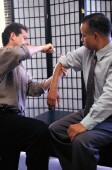For most, PT plus placebo or steroid injection similar to no treatment at all
FRIDAY, Oct. 2, 2015 (HealthDay News) — Most patients with acute lateral epicondylitis recover without physical therapy and steroid injections, according to a study published recently in BMC Musculoskeletal Disorders.
Morten Olaussen, M.D., a specialist in family medicine at the University of Oslo, and colleagues looked at outcomes for 177 Norwegian patients with a recent onset (within three months) of lateral epicondylitis pain. Each was randomly assigned to one of three groups: either no treatment except for drugs such as naproxen; physical therapy for 12 sessions along with two corticosteroid injections to reduce inflammation; or 12 sessions of physical therapy and two placebo injections. Patients underwent the therapies for six weeks and were tracked for one year. At the end of that time, 157 patients had completed the study.
The researchers found that, overall, improvement with physical therapy plus placebo injection or steroid injection was about the same as with no treatment at all. For three-fourths of the patients, the elbow pain had disappeared at one year, regardless of which group they were in. But at least one-quarter still had symptoms at one year. At the six-week point, physical therapy combined with steroid injections was helpful compared to placebo injections with physical therapy. But for most outcomes, physical therapy with steroid injections was linked to worsening at 12 and 26 weeks after initial reports of improvement.
“Physiotherapy with deep transverse friction massage, Mills manipulation, stretching, and eccentric exercises showed no clear benefit, and corticosteroid injection gave no added effect,” the authors conclude. “Corticosteroid injections combined with physiotherapy might be considered for patients needing a quick improvement, but intermediate (12 to 26 weeks) worsening of symptoms makes the treatment difficult to recommend.”
Copyright © 2015 HealthDay. All rights reserved.








